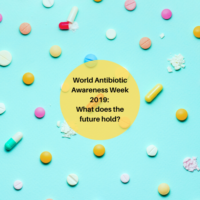World Antibiotic Awareness Week takes place this year between 18-22nd November. Antibiotic resistance is one of the greatest threats to public health. It’s clear that increasing our awareness and understanding is crucial in tackling this crisis, but is it already too late?
Before the discovery of antibiotics, a simple cut to the skin was fatal. The introduction of penicillin in the 1940s was one of the greatest medical advances in history, saving countless lives ever since. Hailed as a wonder drug, there seemed no limit to its beneficial effects; however, in recent years, our eyes have been opened to the dire consequences that come with the overuse of antibiotics.
Antibiotics destroy bacterial cells by disrupting various mechanisms that only bacterial cells – not human cells – possess. These include rupturing the bacterial cell wall, preventing protein synthesis or causing irreparable breaks in the bacterial DNA.
Microbial Resistance to Antibiotics
Antibiotic resistance is acquired through several different means. For example, mutations in the DNA may confer some form of resistance. Moreover, resistance can be obtained through horizontal gene transfer during which a resistant bacterium transfers genetic material to another bacterium. Various molecular mechanisms are utilised by bacteria in their resistance to antibiotics. Some bacteria may have an impermeable cell wall or produce chemicals that inactivate the antibiotic, whilst some may have an efflux mechanism that transports the antibiotic out.
Selective Pressure
How does the overuse of antibiotics contribute to bacterial resistance?
The main explanation for this is through the process of selective pressure. During a bacterial infection, the population of bacteria may contain a few with resistant genes. The antibiotic will kill most of the bacterial population, but the resistant ones are able to survive and grow. These can then be spread from person to person.
What does the future hold?
According to the CDC, more than 2.8 million people in the United States alone experience an infection from antibiotic-resistant bacteria with 35,000 deaths every year. Thus, there is an urgent need to address this crisis as these numbers will only go up.
Overuse of antibiotics is the main cause of resistance. Thus, developing better diagnostics of infections will prevent physicians from prescribing antibiotics for the wrong illnesses. Moreover, educating patients about the importance of following dosage instructions will go a long way to lowering resistance. These are strategies that can be implemented rapidly and will contribute greatly to lowering the chance of antibiotic resistance occurring.
Furthermore, it is thought the much higher use of antibiotics in the farming industry has also contributed to resistance. Thus more stringent policies are needed to lower the overuse of antibiotics in farm animals.

Scientists are also researching into alternative therapies such as the use of bacteriophages, vaccines and antibodies. For example, a research team from the University of Pittsburgh and the Howard Hughes Medical Institute successfully treated a patient suffering from a severe liver infection using bacteriophages (bacteria-eating viruses).
Antibiotic resistance is a major health crisis and without changes to policies and regulations, it will only become worse. Whilst scientists all over the world are working tirelessly to find alternative drugs, it is important for us to educate ourselves on this pandemic and each do our bit to lower the chance of antibiotic resistance occurring!





